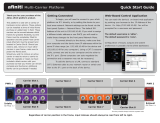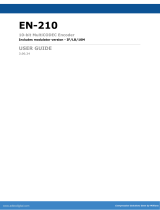
2 RF Rx MENU (LB - IRD with Integrated Demodulator)
Enables or Disables RF input.
note: When RF1 and RF2 are both enabled,
maximum tuner performance is affected. Please
view table in Appendix A for symbol rate and
modcod resource limitations.
Allows the operator to enter the satellite downlink
frequency. The value for the Downlink frequency is
used with the Local Oscillator frequency to
calculate the L-Band frequency. The Downlink and
Local Oscillator frequencies can be used to
determine if spectrum inversion occurs using the
following rules. If the Downlink frequency is less
than the Local Oscillator frequency, then spectrum
inversion does occur. If the Downlink frequency is
greater than the Local Oscillator frequency, then
spectrum inversion does not occur.
Range dependent upon LO
configuration
2.3
Local
Oscillator
(MHz)
The Local Oscillator (L.O.) control specifies the
frequency of the LNB local oscillator. The standard
L.O. frequencies for “C” and “Ku” bands are
5150MHz and 10750MHz respectfully although,
some other variants are included. If the desired
L.O. frequency is not listed, select either C:
Manual or Ku: Manual and enter the L.O.
frequency in the Manual L.O. field.
C: 5150
KU: 11300
KU: 10750
KU: 10600
KU: 10000
KU: 9750
KU: 9600
C: MANUAL
KU: MANUAL
Allows manual entry of the LNB Local Oscillator
frequency provided that either C: Manual or Ku:
Manual is selected from the Local Oscillator
pulldown menu.
Allows the operator to enter the L-Band frequency
within the range from 950MHz to 2.15GHz. The
value entered in this field is used with the Local
Oscillator frequency to calculate the Downlink
frequency using the following rules. If Downlink <
Local Oscillator, then Downlink - Local Oscillator =
│L-Band│. If Downlink > Local Oscillator, then
Downlink - Local Oscillator = L-Band
2.6
Acquisition
Range
(MHz)
Acquisition Range is defined as the range of
frequencies that the tuner will scan in order to
achieve carrier synchronization. Allows the
operator to select the range of frequencies that
the RF tuner will sweep through to acquire the
carrier. e.g. If the desired carrier is at 1.080GHz
and the Acquisition Range is set to 5MHz, the RF


































